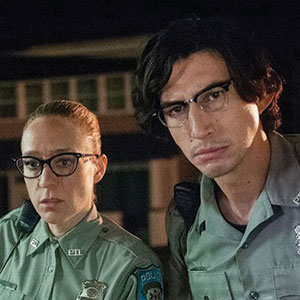

Like the zombies here, Jim Jarmusch’s The Dead Don’t Die is dead on its feet and ambling toward no clear destination. The existential nonchalance of his many films (Down By Law, Only Lovers Left Alive, Patterson) harmonize nicely with love stories of bemused, alienated characters. It doesn’t quite work with horror-show material.
Horror doesn’t seem to interest him that much, except in a phantom limb sort of way, as in the tingle of remembering the thrill of late night movies decades ago. Thus the references here to Creepy magazine and Cleveland TV horror show host Ghoulardi, honored in both image and taglines (“Stay sick!” “Turn blue!”). Jarmusch is shooting in the Hudson Valley of New York. The terrain looks reasonably like the rural, hilly and Rust Belt-tinged Pittsburgh-land locations that George Romero used more than 50 years ago for Night of the Living Dead.
Centerville, population 738: “A real nice place,” says the welcome sign; fans of Zappa’s 200 Motels, this one’s for you. Police Chief Cliff Robertson (Bill Murray) and officer Ronnie (Adam Driver) investigate a chicken theft; the mild-mannered pair are easily run off by the accused thief Hermit Bob (Tom Waits) who is living in the bushes. (Anyway, the chicken belonged to a racist farmer who no one likes.) As they head back to the cop shop, the policemen are worried over the unnatural amount of daylight and televised reports that polar fracking may knock the globe off its magnetic axis. “This isn’t going to end well,” says Ronnie, early on.
Other signs and wonderscrazy ant colonies and phosphorescent mushroomsmirror troubling eccentricities in the small town. One is the arrival a new Scottish mortician (Tilda Swinton) who seems to fancy herself a samurai. By stumbling into a hole in the cemetery, Chief Robertson discovers that the dead are gophering their way out of their graves.
The zombie attacks make the cops more laconic than they are already; the other member of the three-cop force, officer Mindy (Chloe Sevigny) is the one who actually expresses emotions and faces the hordes of walking dead with some understandable hysteria. In the meantime, the film is packed with dialogue reminiscent of notebook jottings. A person describes the plot of The Great Gatsby through vague memories. Wu-Tang Clanner RZA, as a delivery man, asks for a confirmation signature (from the squandered Caleb Landry Jones, gas station attendant and horror fan-boy): “I just need your Herbie Hancock right here.” The odd droll joke freshens this movie’s anti-humor: zombs milling around a pharmacy, moaning for “Oxy…oxy…” or clutching their smartphones (“Wiii-fiiii…) Officer Mindy is dispatched to do crowd control outside of a crime scene, when the crowd consists of three worried people.
By the time the frame is brokena tacit admission that the film isn’t workingThe Dead Don’t Die has gone from puzzling to dull. Gnaw away as he does, Jarmusch can’t find new flavor in the long-standing idea that zombies represent the ultimate stage of capitalism. Zombies have served as parodies of hypnotized consumers for 40 years now, ever since the first Dawn of the Dead. Recall Anna Kendrick’s retort in Twilight: New Moon: “And, like, is it supposed to be a metaphor for consumerism? Because don’t be so pleased with your own, like, self-referential cleverness, you know? Like, some girls like to shop.”
While there’s some passing blows against Trumpism, The Dead Don’t Die walks away from one potential avenue of metaphor, about how zombie films can parody good old American xenophobia. (Thus, a strange, out-of-nowhere passage where Ronnie mentions how much he likes Mexico and the Mexcians.)
The tone is like a New Yorker cartoon mocking a particularly bloody Goya painting; it’s too cozy to be grisly. Jarmusch tries his usual method of directing warm, humane actors as they negotiate a zone of vagueness and disconnectedness. It doesn’t work here, even with celebrity zombs including Selina Gomez, Carol Kane and Iggy Pop. From foreshadowing to end-game turkey shoot, it’s an exhausted movie.
Nostalgia is obviously not what it used to be. Recall the wonderful advertising tag line for Wes Craven’s 1972 The Last House on the Left: “To avoid fainting, keep telling yourself, ‘It’s only a movie, it’s only a movie…'” The effect is different when a director is the one who keeps telling you it’s only a movie.
The Dead Don’t Die
R; 104 Mins.
Valleywide


